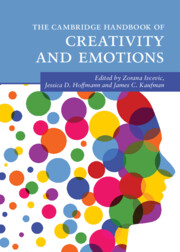Book contents
- The Cambridge Handbook of Creativity and Emotions
- Cambridge Handbooks in Psychology
- The Cambridge Handbook of Creativity and Emotions
- Copyright page
- Dedications
- Contents
- Figures
- Tables
- Contributors
- Acknowledgments
- Creativity and Emotions
- Part I Methods in the Study of Creativity and Emotions
- Part II The Development of Creativity
- 5 Affective States and Creativity
- 6 The Neuroscience of Creativity and Emotions
- 7 Attention, Affect, and Creativity, from Mindfulness to Mind-Wandering
- 8 Motivations, Emotions, and Creativity
- 9 Managing Difference and Uncertainty and Creativity
- 10 Creativity and Emotional Intelligence
- 11 Emotions across the Creative Process and across Domains of Creativity
- Part III Emotions and the Creative Person
- Part IV Emotions and Creative Products
- Part V Emotions and Creativity at School and Work
- Index
- References
9 - Managing Difference and Uncertainty and Creativity
from Part II - The Development of Creativity
Published online by Cambridge University Press: 16 February 2023
- The Cambridge Handbook of Creativity and Emotions
- Cambridge Handbooks in Psychology
- The Cambridge Handbook of Creativity and Emotions
- Copyright page
- Dedications
- Contents
- Figures
- Tables
- Contributors
- Acknowledgments
- Creativity and Emotions
- Part I Methods in the Study of Creativity and Emotions
- Part II The Development of Creativity
- 5 Affective States and Creativity
- 6 The Neuroscience of Creativity and Emotions
- 7 Attention, Affect, and Creativity, from Mindfulness to Mind-Wandering
- 8 Motivations, Emotions, and Creativity
- 9 Managing Difference and Uncertainty and Creativity
- 10 Creativity and Emotional Intelligence
- 11 Emotions across the Creative Process and across Domains of Creativity
- Part III Emotions and the Creative Person
- Part IV Emotions and Creative Products
- Part V Emotions and Creativity at School and Work
- Index
- References
Summary
Diversifying experiences, defined as “unusual and unexpected events or situations that push people outside the realm of normality”, include a wide range of experiences, both negative and positive, which reflect difference and uncertainty. We argue that successfully managing diversifying experiences at the individual level may foster creativity. Thus, we will use the diversifying experiences and creativity framework to present empirical evidence and theoretical arguments that illustrate the link between managing uncertainty/difference and creativity. First, we will present empirical evidence for the link between four broad categories of diversifying experiences and creativity: psychopathology, adversity, enrichment, and diversity. Second, we will discuss the possible mechanism of managing such experiences (at the individual level) in a way that fosters creativity. Third, we will discuss future directions.
- Type
- Chapter
- Information
- The Cambridge Handbook of Creativity and Emotions , pp. 167 - 185Publisher: Cambridge University PressPrint publication year: 2023

